Spatial Dynamics and Social Interactions in Planning Open Spaces of Dense Musi Riverside Settlements, Palembang
DOI:
https://doi.org/10.19184/geosi.v10i1.51702Keywords:
Urban Planning, Open Space Planning, Social Interaction, Riverside SettlementAbstract
Providing open space in densely populated settlements is challenging due to the lack of open land. In contrast, open space is essential in these settlements as a place for social interaction in highly communal settlements. In addition to these challenges in riverbank settlements, planning open space is also necessary, considering the landscape's characteristics and the settlement's unique culture. This study investigates the potential of alternative spaces as a solution for providing open space. The study began by observing the population's activities to be mapped according to age group and gender. Data were collected in settlements along the banks of the Musi River in Palembang. Identification began by mapping open space on a spatial map showing the location and distribution and the type of open space in the settlement area. Open space is formed informally in various spaces in the settlement. Multiple demographic groups generally use six types of open space. Furthermore, the data was processed using contingency and distribution analysis to see the size of the group in activities in the open space, the activities carried out, and the location of the open space. The results of the analysis show that different needs and patterns of involvement in groups of adults, adolescents, and children must be considered in planning and design. This study concludes that optimizing open spaces according to residents' activity patterns can solve the limitations. Riverbanks have the potential to serve as open spaces, requiring further longitudinal and qualitative research to understand usage patterns and community perceptions.
Downloads
Downloads
Published
How to Cite
Issue
Section
License
Copyright (c) 2025 Geosfera Indonesia and Department of Geography Education, University of Jember

This work is licensed under a Creative Commons Attribution-ShareAlike 4.0 International License.




